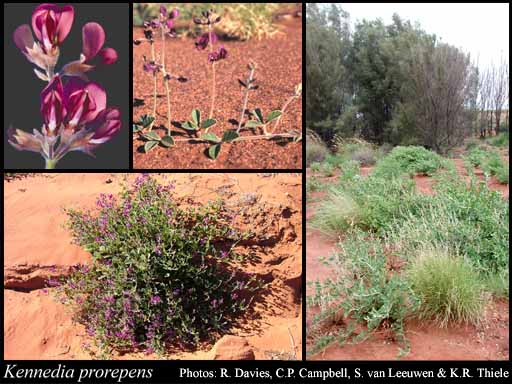- Reference
- Syst.Census Austral.Pl. 41 (1882)
- Conservation Code
- Not threatened
- Naturalised Status
- Native to Western Australia
- Name Status
- Current
Prostrate or ascending shrub, 0.05-0.6(-1) m high, to 2 m wide. Fl. purple-violet-blue, Apr to Nov. Red sand, gravelly soils, laterite. Sandplains, roadverges, creeklines.







Scientific Description
Genus Kennedia. Form prostrate,spreading or scrambling. Habit shrub, spindly shrub (broom-like). Stems Indumentum glabrous, Pustules or glands absent, Striation (stems ribbed) not striate, Cross section terete, Spiny on any part of plant not spiny. Leaves or phylloclades Presence clearly present, Position alternate, Leaves compound, Leaves or phylloclade continuous with stem not continuous with stem, Cross section of leaf or leaflet flat with flat margins, Margins of leaf or leaflet entire, Tuberculate tubercles absent, Pustules or glands absent. Length Leaf length 26-45. Width (entire leaves only) Leaf width NaN (?). Scale leaves length mm long NaN (?). Leaflets Number three, Arrangement pinnately arranged. Terminal leaflet Presence present, Stalk stalked. Indumentum Presence hairy, Type simple. Stipules Presence present and persistent to older leaves, Glands without glands, Ribs ribless. Length Stipule length 4-6. Bracteoles Presence absent, Indumentum hairy (?) or glabrous (?), Striation striate (?) or not striate (?). Length Bracteole length NaN (?). Pedicel Presence present, Indumentum hairy. Length Pedicel length 1.5-3. Calyx Pustules or glands absent, Ribs ribless, Enlarged in fruit not accrescent. Length Calyx length 5.5-7. Indumentum Presence hairy, Type with simple hairs. Corolla Colour patterning multicoloured, Colour (when multicoloured - choose one colour) yellow, pink, purple or blue, Colour (when multicoloured - choose a second colour) yellow, pink, purple or blue, Petal claws ( the narrow base of the petals present. Length Corolla length 10-17. Indumentum Presence absent. Standard Indumentum glabrous, Auricles auriculate. Length Standard length 9.5-15.5. Wings Auricles not auriculate. Length Wing length 9-12. Keel Auricles not auriculate, Indumentum glabrous, Beak not beaked. Length Keel length 10-12. Stamens Number ten. Anthers anther length 0.8-1, Position at two different levels (filaments alternately long and short). Filaments Fusion united in an open sheath with one free stamen. Length Filament length 7-12. Ovary Placement sessile or subsessile. Indumentum Presence glabrous. Style Indumentum glabrous, Bearded ( with a tuft of hairs at apex ) not bearded, Apex terete. Length Style length 8.2-11. Fruit Type dehiscent (a pod or follicle), Constriction not constricted between the seeds, Compression flat or compressed, Placement sessile or subsessile, Beak not beaked. Length Fruit length 28-33. Width Fruit width 5-6. Indumentum Presence glabrous. Flowering time April, May, June, July, August, September, October or November. Distribution Botanical Province Northern, Eremaean or South-West, IBRA Bioregion Great Sandy Desert, Pilbara, Gascoyne, Little Sandy Desert, Gibson Desert, Central Ranges, Yalgoo, Murchison, Great Victorian Desert, Dampierland, Coolgardie, Geraldton Sandplains, Avon Wheatbelt, Mallee or Esperance.
Distribution
- IBRA Regions
- Avon Wheatbelt, Central Ranges, Coolgardie, Dampierland, Esperance Plains, Gascoyne, Gibson Desert, Great Sandy Desert, Great Victoria Desert, Little Sandy Desert, Mallee, Murchison, Pilbara, Yalgoo.
- IBRA Subregions
- Augustus, Carnegie, Central, Chichester, Eastern Goldfield, Eastern Murchison, Fitzgerald, Fitzroy Trough, Fortescue, Hamersley, Lateritic Plain, Mackay, Mann-Musgrave Block, Merredin, Shield, Southern Cross, Tallering, Trainor, Western Mallee.
- Local Government Areas (LGAs)
- Ashburton, Coolgardie, Cue, Derby-West Kimberley, Dundas, East Pilbara, Kalgoorlie-Boulder, Kellerberrin, Kondinin, Laverton, Leonora, Meekatharra, Menzies, Murchison, Ngaanyatjarraku, Ravensthorpe, Sandstone, Westonia, Wiluna, Yilgarn.